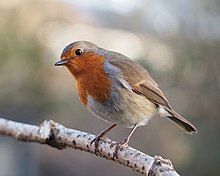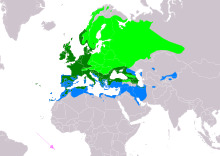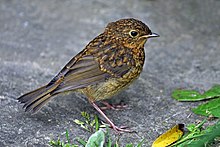
Back Rotkehlchen ALS Erithacus rubecula AN أبو الحناء الأوروبي Arabic ابو الحناء الاوروبى ARZ Erithacus rubecula AST Şəfəq quşu Azerbaijani Таң турғайы Bashkir Lėipsnalė BAT-SMG Заранка Byelorussian Малінаўка (птушка) BE-X-OLD
| European robin | |
|---|---|

| |
| Call recorded in Gran Canaria | |
| Scientific classification | |
| Domain: | Eukaryota |
| Kingdom: | Animalia |
| Phylum: | Chordata |
| Class: | Aves |
| Order: | Passeriformes |
| Family: | Muscicapidae |
| Genus: | Erithacus |
| Species: | E. rubecula
|
| Binomial name | |
| Erithacus rubecula | |
| Subspecies | |
|
7–10, see text. | |

| |
| Range of E rubecula Breeding Resident Non-breeding Possible extinct & Introduced
| |
| Synonyms[2] | |
| |

The European robin (Erithacus rubecula), known simply as the robin or robin redbreast in the British Isles, is a small insectivorous passerine bird that belongs to the Old World flycatcher family Muscicapidae.[3] It is found across Europe, east to Western Siberia and south to North Africa; it is sedentary in the west and south of its range, and migratory in the north and east of its range where winters are harsher.
It is 12.5–14.0 cm (4.9–5.5 in) in length; the male and female are identical in plumage, with an orange-toned red breast and face lined with grey, brown upper-parts and a whitish belly. Juveniles are distinct, freckled brown all over and without the red breast; first-winter immatures are like the adults, except for more obvious yellow-brown tips to the wing covert feathers (inconspicuous or absent in adults).
- ^ BirdLife International (2018). "Erithacus rubecula". IUCN Red List of Threatened Species. 2018: e.T22709675A131953953. doi:10.2305/IUCN.UK.2018-2.RLTS.T22709675A131953953.en. Retrieved 19 November 2021.
- ^ "Erithacus rubecula". Global Biodiversity Information Facility. Retrieved 21 January 2022.
- ^ Cite error: The named reference
iocwas invoked but never defined (see the help page).
